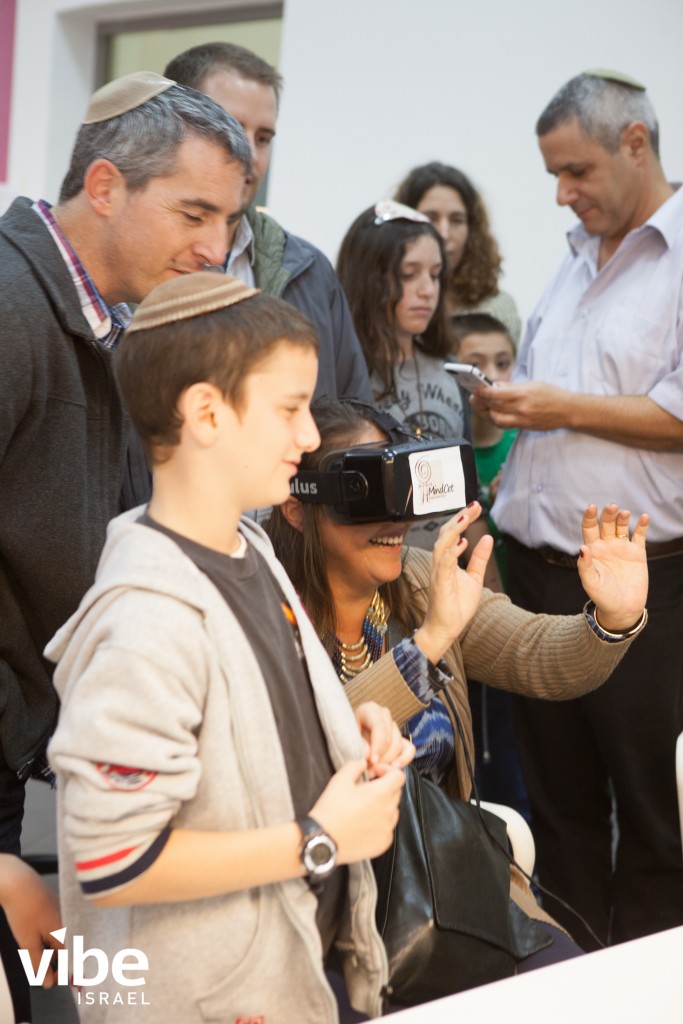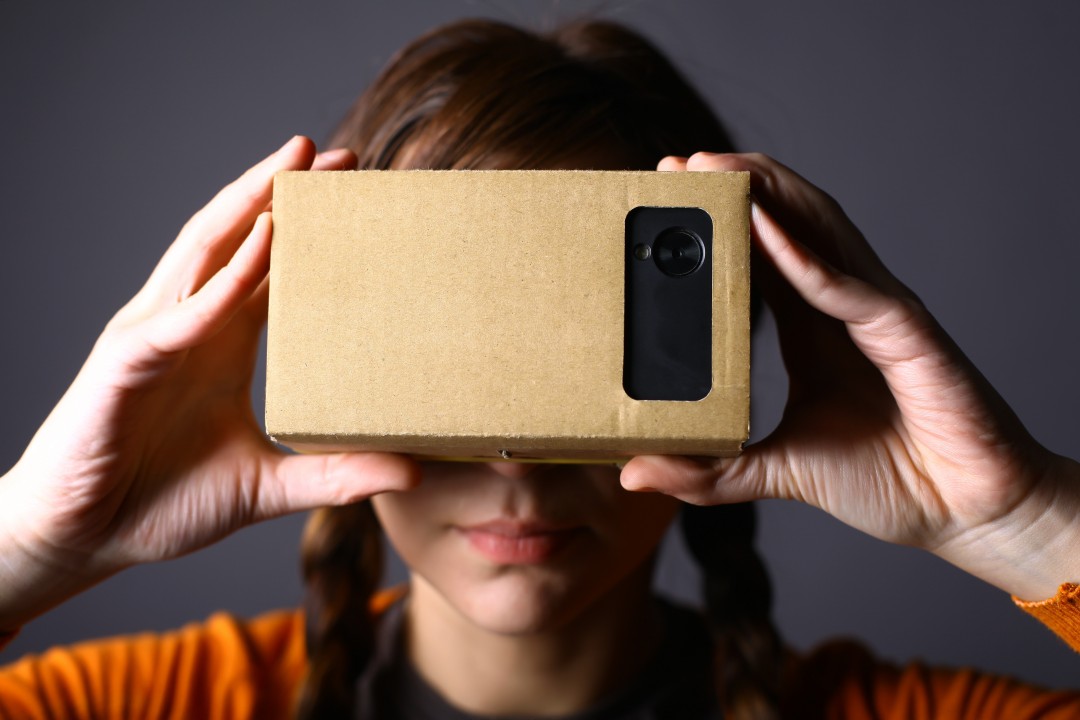While we may not have flying cars, hover boards that really hover (and don’t catch fire), or teleporters just yet, the past year has seen the launch of at least one future-age technology we’ve awaited for decades: virtual reality.
You’ve probably heard about Oculus Rift and other similar “prosumer” level devices, or professional-quality devices made for the average consumer that are rapidly making their way to production.
However, it seems that a much more primitive technology has eclipsed the mass market: simple pieces of cardboard. Believe it or not, that’s great news for educators. Let’s find out why…
A First Experience
I had my first hands-on experience with Virtual Reality (VR) while on a recent whirlwind trip to Israel to learn about education innovation taking place in the Middle Eastern country.
We were visiting MindCET, one of the largest EdTech start-up hubs and accelerators in the world. There, in a small town in the middle of the Negev desert, was a team of researchers, entrepreneurs and middle-school kids working on an Oculus Rift – a device that doesn’t technically even launch for the general public until next March!

Once you put the headset on, you are immersed in an entirely new world. You see through the eyes of another to figure out what or who you are. The idea is that these simulations can aid in learning about perspective and encourage dialogue around seeing the world differently.
It turns out that I had a tail, and in my shadow, I discovered that I was, in fact, a dog. It was crazy real.
There was a pretty major downside for me – I get motion sickness on boats and long car rides, and it only took a minute or so before this simulation had me not feeling well. If VR really takes off, this will be something to figure out how to overcome for sure!
It also can be a little too immersive. With headphones on and the glasses completely covering your field of vision, you may feel vulnerable, unaware of your actual real-life surroundings, and you must trust those around you to keep you safe.
Seriously though, check out the smiles in all of these kids faces as they tried this same exact simulation for the first time. That is proof enough to know that this technology is engaging and the potential is real.
While visiting MindCET, I also had my first experience with another virtual reality device – Google Cardboard.
What Is Google Cardboard?
Google Cardboard is actually cardboard (like from boxes) that is folded in such a way that it can hold a smartphone. There are plastic lenses that can bend the light in just the right way to create 3D images. The result is something reminiscent of those familiar 3D viewers from our childhood – you simply hold the cardboard up to your face and look through the eye holes. The experience, in many ways, is similar to the more expensive dedicated virtual reality devices.

The beauty of Cardboard is that it is affordable. I recently picked up a kit for $13 dollars on Amazon, and you can find them for as low as $5 each.
Pro tip: I’m nearsighted, and everything in Google Cardboard is really blurry when I wear my glasses or contacts. I thought my cardboard was broken for the first few days!
Virtual Reality Apps For Learning
While Google and others work to further develop the hardware platform, a variety of apps are already waiting to provide the actual content you can use in learning activities. The unimersiv.com site seems to be the best complete directory of VR apps for learning out there. Here are some of my favorites so far:
Discovery VR: Though this app isn’t specifically for educators, it’s still a great introduction to virtual reality’s ability to transport you to new locations. With a variety of 360-degree videos available, you can take your classroom everywhere from the depths of the Amazon River to the heights of orbit above the Earth.
Titans of Space: This app is one of the earliest VR programs that started the groundswell of enthusiasm for the technology, and once you’ve had a look at its jaw-dropping space vistas, you’ll understand why.
InMind VR: What better way is there to make a boring biology lesson exciting than to take your classroom into an actual human brain? This app lets you explore all the highlights of neural anatomy while hunting down the neurons causing a psychological disorder for the patient.
Cardboard Camera: Figuring out how to get students involved in content creation (not just sitting and experiencing) will be a differentiator in the educational impact of VR. The Cardboard Camera app is the closest we have to that at the moment, as it allows students to create videos that can be imported into VR videos to then view in Cardboard or other VR devices.
Google Expeditions: While not technically available just yet, I ran across this at the TCEA conference last month. This Google-created app allows you to load up a variety of locations to every student’s phone while they’re using Google Cardboard. Through the app, you can take your students on a virtual tour of that location. Best of all, you can control what they see so that curious eyes stay focused on the material you’re teaching. Google is running an Expeditions Pioneer program through the end of the 2016 school year, which you can sign up for if it’s available in your area. The ability to control each students’ VR headset and push out apps will be a true game changer once Expeditions is ready for all.
If VR Does One Thing
We all know that distractions, ADD, and multi-tasking are some of the biggest barriers we face with students in our classrooms. Given that, the potential benefits of incorporating virtual reality into your daily classroom environment are clear. When you have a VR headset on or Google Cardboard in front of your face, it is nearly impossible to be distracted or to not pay attention.
While the first wave of virtual reality apps serve as innovative teaching tools and eye-catching advertisements for the technology, you can count on developers to begin offering fully fledged, tailor-made programs geared specifically toward educators and students in the near future. Interactive historical re-creations, immersive assessments, distraction-free simulations – the opportunities are truly not based in current reality.
I. Can’t. Wait.
*More on Vibe Israel and our Innovation in Education tour found here.
**Photos by the talented Amit Shemesh.

In my Web Marketing class, we actually just recently learned how to use Google Cardboard. Before seeing or ever hearing about it, I Honestly probably wouldn’t have tried it. However, after trying it it is really interesting to see and use. We also do 360 degree photos in my class. Doing that helps me understand, “Hey this is how it’s made!” and helps me appreciate it so much more for what it is. I think it’s a fun kind of “get away” and actually puts you in a videogame-like atmosphere. Its cool to be able to see what others are making and putting out there. What I thought was even better, was the option of viewing the 360 video channel. I really enjoyed that. It allowed me to watch music videos and movie trailers and actually put you there in those scenes. However, similar to your case, It does make me get slight headaches due to the fact I am also nearsighted and don’t wear my glasses with it, but I still have fun with it. Also, another point you said, it is cheap and a fun experience. Thanks for sharing!
I completely agree that this is an amazing breakthrough for students who struggle with sitting still. I know that this would have really been effective in my learning throughout grade school. Another site that really shows how this device is used is http://toolofna.com/#!//work/8-phases-of-enlightenment. It has really cool effects and if a school is tailored to teaching coding, this could be shown as motivation for the students because it could potentially be something they could create someday!
Really great thing …
this looks like it could really change the world. its so good.
This looks like it could really change the world a couple years from now.
https://fsuwebtools.wordpress.com/2016/01/27/google-cardboard-camera/
See bottom of article for the ultimate effect of Google Cardboard glasses on the human body.
Thanks for this great article about a great subject, Ronnie! “Key Benefits of Using VR in Education | Affordable virtual reality in school” : http://goo.gl/biL6pm discusses the same topic from a different angle, you might like it. Best, G
I am thinking about starting a blog about virtual reality, as VR is the new iPhone as it seems , what do you think?